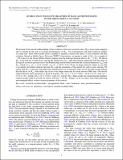| dc.contributor.author | Manara, C. F. | |
| dc.contributor.author | Robberto, M. | |
| dc.contributor.author | Da Rio, N. | |
| dc.contributor.author | Lodato, G. | |
| dc.contributor.author | Hillenbrand, L. A. | |
| dc.contributor.author | Soderblom, D. R. | |
| dc.contributor.author | Stassun, Keivan | |
| dc.date.accessioned | 2015-02-25T13:45:57Z | |
| dc.date.available | 2015-02-25T13:45:57Z | |
| dc.date.issued | 2012-08 | |
| dc.date.submitted | 2012-05 | |
| dc.identifier.issn | 0004-637X | |
| dc.identifier.issn | 1538-4357 | |
| dc.identifier.uri | http://hdl.handle.net/1721.1/95503 | |
| dc.description.abstract | The present observational understanding of the evolution of the mass accretion rates ([dot over M][subscript acc]) in pre-main-sequence stars is limited by the lack of accurate measurements of [dot over M][subscript acc] over homogeneous and large statistical samples of young stars. Such observational effort is needed to properly constrain the theory of star formation and disk evolution. Based on Hubble Space Telescope/WFPC2 observations, we present a study of [dot over M][subscript acc] for a sample of ~700 sources in the Orion Nebula Cluster, ranging from the hydrogen-burning limit to M [subscript *] ~ 2 M [subscript ☉]. We derive [dot over M][subscript acc] from both the U-band excess and the Hα luminosity (L [subscript Hα]), after determining empirically both the shape of the typical accretion spectrum across the Balmer jump and the relation between the accretion luminosity (L [subscript acc]) and L [subscript Hα], which is L [subscript acc]/L [subscript ☉] = (1.31 ± 0.03) · L [subscript Hα]/L [subscript ☉] + (2.63 ± 0.13). Given our large statistical sample, we are able to accurately investigate relations between [dot over M][subscript acc] and the parameters of the central star such as mass and age. We clearly find [dot over M][subscript acc] to increase with stellar mass and decrease over evolutionary time, but we also find strong evidence that the decay of [dot over M][subscript acc] with stellar age occurs over longer timescales for more massive PMS stars. Our best-fit relation between these parameters is given by log ([dot over M][subscript acc]/M [subscript ☉] yr) = (–5.12 ± 0.86) – (0.46 ± 0.13) · log (t/yr) – (5.75 ± 1.47) · log (M [subscript *]/M [subscript ☉]) + (1.17 ± 0.23) · log (t/yr) · log (M [subscript *]/M [subscript ☉]). These results also suggest that the similarity solution model could be revised for sources with M [subscript *] [> over ~] 0.5 M [subscript ☉]. Finally, we do not find a clear trend indicating environmental effects on the accretion properties of the sources. | en_US |
| dc.language.iso | en_US | |
| dc.publisher | IOP Publishing | en_US |
| dc.relation.isversionof | http://dx.doi.org/10.1088/0004-637x/755/2/154 | en_US |
| dc.rights | Article is made available in accordance with the publisher's policy and may be subject to US copyright law. Please refer to the publisher's site for terms of use. | en_US |
| dc.source | American Astronomical Society | en_US |
| dc.title | HUBBLE SPACE TELESCOPE MEASURES OF MASS ACCRETION RATES IN THE ORION NEBULA CLUSTER | en_US |
| dc.type | Article | en_US |
| dc.identifier.citation | Manara, C. F., M. Robberto, N. Da Rio, G. Lodato, L. A. Hillenbrand, K. G. Stassun, and D. R. Soderblom. “HUBBLE SPACE TELESCOPE MEASURES OF MASS ACCRETION RATES IN THE ORION NEBULA CLUSTER.” The Astrophysical Journal 755, no. 2 (August 6, 2012): 154. © 2012 The American Astronomical Society | en_US |
| dc.contributor.department | Massachusetts Institute of Technology. Department of Physics | en_US |
| dc.contributor.mitauthor | Stassun, Keivan | en_US |
| dc.relation.journal | The Astrophysical Journal | en_US |
| dc.eprint.version | Final published version | en_US |
| dc.type.uri | http://purl.org/eprint/type/JournalArticle | en_US |
| eprint.status | http://purl.org/eprint/status/PeerReviewed | en_US |
| dspace.orderedauthors | Manara, C. F.; Robberto, M.; Da Rio, N.; Lodato, G.; Hillenbrand, L. A.; Stassun, K. G.; Soderblom, D. R. | en_US |
| mit.license | PUBLISHER_POLICY | en_US |
| mit.metadata.status | Complete | |
